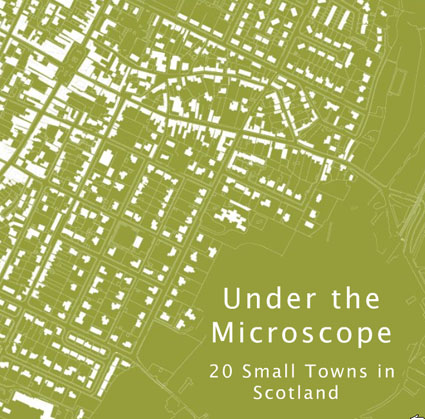Ref: Hart L, Hooi J, Romice O, Porta S, (2010), Under the microscope: 20 small towns in Scotland, University of Strathclyde, Glasgow UK.
Download the book:
*** ***
“20 Towns Under the Microscope” (*) continues the tale of Scottish Small Towns that was initiated with “An comman”, and more specifically deals with their fine-grained urban morphology. This means, by and large, that of the many – and possibly innumerable – aspects of Scottish Small Towns that could be approached and investigated with good reasons in order to understand how they work and have developed, this study focuses on just one of them: their form. This is the field of urban morphology, a side-stream in the wider area of urban studies.
Despite the fact that cities have always been described and illustrated in terms of how they look like, urban morphology is still surprisingly marginal for those who dig into how cities work and what are their multifaceted dynamics. For some reasons, getting into the very form of cities has long been considered somehow trivial, super-structural, marginal, compared to studies on their societal forms, economy or policies. Even the relatively recent emphasis on the environment has left urban form mostly untouched, as the term “environment” is here intended as the complex relationships between resources and wastes in the ecological cycle, something that does not principally include urban form in its popular meaning.
As for urban planning and design, it is only in the last couple of decades that the form of cities has re-gained centre stage, at least at the forefront of research. This new interest into urban form in the field of Urban Design results from the need for a new humanism in the disciplines of the built environment, a radical and profound paradigm shift from the world-as-a-machine. It inaugurates a completely different way of understanding and governing cities.
This study is inevitably reminiscent of the two radical reforms that came to the urban morphology field through the works of M.R.G Conzen in Britain and Saverio Muratori in Italy between the fourth and the seventh decade of the XXth Century, then enhanced by scientists like Jeremy Whitehand, Peter J. Larkham, Gianfranco Caniggia, Gian Luigi Maffei and many others including the great French tradition, best represented by Panerai-Castex-Depaule study on the urban block, probably one of the single most important works in the disciplines of the built environment in the whole last Century. As the reader will appreciate in this publication, urban morphology allows to understand and explain change through the observation of form and its alterations through time. As such, it is a clear, unspoilt insight into the past of a place, a natural, straightforward way to understand its in-depth meaning. Simple progression of figure ground at key time lapses, intertwined with an insight into population changes, major factors of transformation, economic events of significance, explain how the life and form of towns developed. Structures, types – of built or open space- all respond to a special path of events, and they are key to future change.
While “An Comann. 50 Small Scottish Towns” presented this narrative through the story of 50 small Scottish towns, selected by size and classified by seven type according to their character, “20 Small Towns under the microscope” (*) offers an in-depth investigation of 20 towns selected as representative of the seven types in An Comann. Each town is located in its landscape and immediate context, described through demographic and social/usage figures, but most of all its structure, form and performance (accessibility, density and others) are illustrated graphically with legible, telling, unequivocal clarity. Then, each town is meticulously presented through character areas, described through time-snapshots to explain how overall structure, blocks, plots, frontages, setbacks etc are intrinsically linked to dynamics such as usage, type, movement and commercial activity.
“An Comann” and “20 Small Towns Under the Microscope” (*) are a kaleidoscope of information: they are an historic document, tracing development over centuries. They are a social and economic barometer, showing life changes as a consequence of key events. They are an urban and social atlas of life traced through our beloved settings. And even more, they are a clear indication for future development.
(*) “20 Small Towns Under the Microscope” is a joint project developed by Joanna Hooi and Laura Hart from February to September 2009 between the Urban design Studies Unit of Department of Architecture at the University of Strathclyde and Architecture and Design Scotland.



